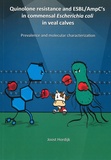Quinolone resistance and ESBL/AmpC’s in commensal Escherichia coli in veal calves
Prevalence and molecular characterization

Hordijk, Joost
- Promoter:
- Prof.dr. D.J. (Dik) Mevius & prof.dr. J.A. (Jaap) Wagenaar
- Research group:
- Wagenaar
- Date:
- February 28, 2013
- Time:
- 12:45 h
Summary
In this thesis the prevalence and molecular characteristics of resistance to (fluoro)quinolones and Extended Spectrum Cephalosporins (ESC) in veal calves were described using Escherichia coli as an indicator organism. Ciprofloxacin and nalidixic acid were used as indicator antimicrobials for quinolone resistance. From all randomly selected E. coli, isolated in 2007 for antimicrobial resistance surveillance purposes, 14% was reduced susceptible. All reduced susceptible isolates carried one or more mutations in the Quinolone Resistance Determining Region (QRDR) of the gyrA gene. Approximately 50% of the reduced susceptible isolates showed additional mutations in the QRDR of parC and/or parE genes. No plasmid mediated quinolone resistance determinants (PMQR) were found in this set of isolates. Cefotaxime was used as an indicator for resistance to ESC. Resistance to ESC is mainly caused by Extended Spectrum Beta Lactamases (ESBLs) or AmpC-type beta lactamases that hydrolyze beta-lactam antibiotics. The genes encoding these beta-lactamases are often located on plasmids. Also mutations in the promoter region of the chromosomal ampC gene may lead to derepression of transcription and reduced susceptibility to ESC. A retrospective study in pooled fecal samples each representing one farm, collected from 1997 to 2010, showed a discontinuous increasing trend in prevalence of resistance to ESC up to 39% in 2010. Various promoter mutations of chromosomal ampC-genes were found in fecal samples in all years. In 2000 blaCTX-M-1, blaTEM-20 and blaTEM-52 were the first ESBL genes observed. Up to 2010 the diversity in ESBL/AmpC genes gradually increased. Most ESBL genes found belonged to the blaCTX-M gene family, of which blaCTX-M-1 was most prevalent, followed by blaCTX-M-14 and blaCTX-M-15. AmpC type genes were found rarely. A second study performed in 100 slaughter batches (10 animals per batch) showed that 66% of the batches were positive for E. coli with reduced susceptibility to cefotaxime. Within-herd prevalence varied greatly, however, from all individual animals tested (n = 1000) 26% were found positive. ESBL gene blaCTX-M-1 was most prevalent, followed by blaCTX-M-14 and -15. The ESBL genes were located on a wide variety of plasmids. blaCTX-M-1 and -15 were predominantly associated with different variants of IncI1 or IncF plasmids. blaCTX-M-14 was predominantly associated with IncK or IncI1 plasmids. In a longitudinal study, fecal samples from individual animals from three farms were screened for E. coli with reduced susceptibility to cefotaxime. The animals were sampled upon arrival at the farm and after three, six, eight and ten weeks (T0 to T10). At T0 18% to 26% of the animals were positive. At T0 all farms showed a similar distribution of mainly blaCTX-M genes. After T0 farm 2 and 3 showed a clonal spread of blaCTX-M-14 on an IncF plasmid (farm 2 + 3) and blaCTX-M-14 on an IncK plasmid (farm 3). On all farms prevalence decreased to (near) 0% while an antimicrobial selection pressure was present.